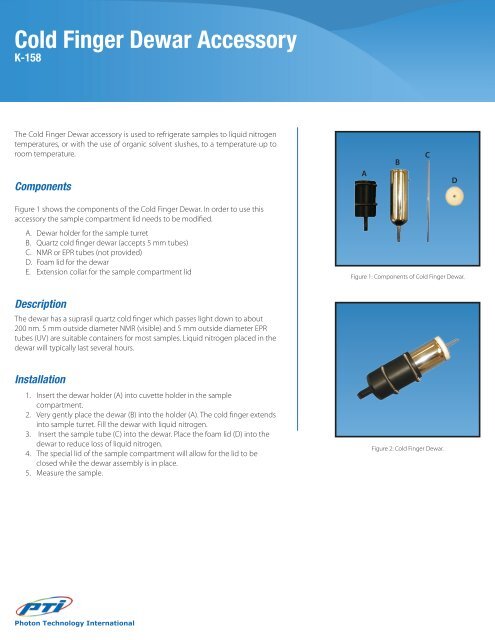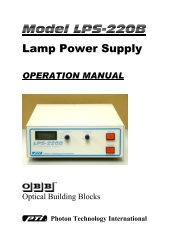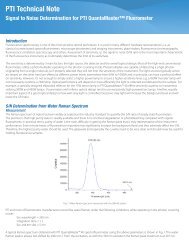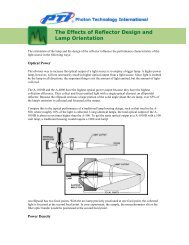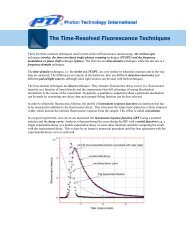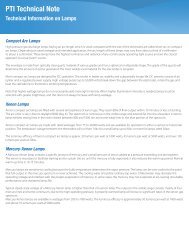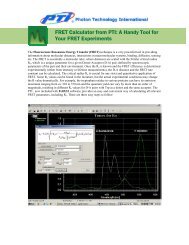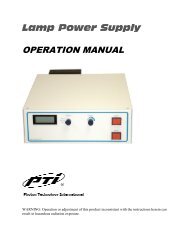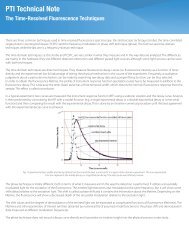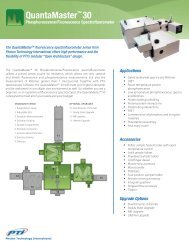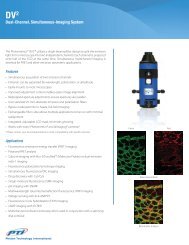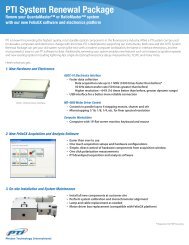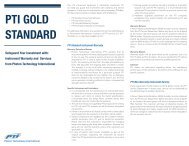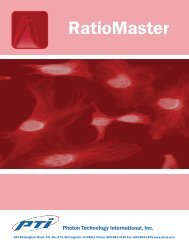Cold Finger Dewar Accessory - Photon Technology International
Cold Finger Dewar Accessory - Photon Technology International
Cold Finger Dewar Accessory - Photon Technology International
Create successful ePaper yourself
Turn your PDF publications into a flip-book with our unique Google optimized e-Paper software.
<strong>Cold</strong> <strong>Finger</strong> <strong>Dewar</strong> <strong>Accessory</strong><br />
K-158<br />
The <strong>Cold</strong> <strong>Finger</strong> <strong>Dewar</strong> accessory is used to refrigerate samples to liquid nitrogen<br />
temperatures, or with the use of organic solvent slushes, to a temperature up to<br />
room temperature.<br />
Components<br />
Figure 1 shows the components of the <strong>Cold</strong> <strong>Finger</strong> <strong>Dewar</strong>. In order to use this<br />
accessory the sample compartment lid needs to be modified.<br />
A.<br />
B.<br />
C.<br />
D.<br />
E.<br />
<strong>Dewar</strong> holder for the sample turret<br />
Quartz cold finger dewar (accepts 5 mm tubes)<br />
NMR or EPR tubes (not provided)<br />
Foam lid for the dewar<br />
Extension collar for the sample compartment lid<br />
Description<br />
The dewar has a suprasil quartz cold finger which passes light down to about<br />
200 nm. 5 mm outside diameter NMR (visible) and 5 mm outside diameter EPR<br />
tubes (UV) are suitable containers for most samples. Liquid nitrogen placed in the<br />
dewar will typically last several hours.<br />
Installation<br />
1.<br />
2.<br />
3.<br />
4.<br />
5.<br />
Insert the dewar holder (A) into cuvette holder in the sample<br />
compartment.<br />
Very gently place the dewar (B) into the holder (A). The cold finger extends<br />
into sample turret. Fill the dewar with liquid nitrogen.<br />
Insert the sample tube (C) into the dewar. Place the foam lid (D) into the<br />
dewar to reduce loss of liquid nitrogen.<br />
The special lid of the sample compartment will allow for the lid to be<br />
closed while the dewar assembly is in place.<br />
Measure the sample.<br />
<strong>Photon</strong> <strong>Technology</strong> <strong>International</strong><br />
A<br />
b<br />
Figure 1: Components of <strong>Cold</strong> <strong>Finger</strong> <strong>Dewar</strong>.<br />
c<br />
Figure 2: <strong>Cold</strong> <strong>Finger</strong> <strong>Dewar</strong>.<br />
d
<strong>Cold</strong> <strong>Finger</strong> <strong>Dewar</strong> <strong>Accessory</strong><br />
K-158<br />
Specifications<br />
Full length:<br />
Internal diameter of the cold finger:<br />
Length of cold finger:<br />
External diameter of the nitrogen<br />
container:<br />
Maximum volume of liquid N2:<br />
Precautions<br />
1.<br />
2.<br />
3.<br />
4.<br />
Approximately 180 mm<br />
6 mm<br />
Approximately 40 mm<br />
Approximately 48 mm<br />
Approximately 133 ml<br />
If a sample tube breaks while in the cold finger, do not attempt to remove it while cold. Instead, remove the liquid nitrogen and let the<br />
dewar warm up; then remove the spilled sample. Attempting to remove a broken tube while frozen may break the cold finger.<br />
It is generally better to freeze the sample first before placing it into the cold finger dewar.<br />
Room air may condense into a sample tube and form a plug if it is open while frozen. The tube may then burst or spray sample solution<br />
when the tube is allowed to warm up. It is recommended that a cap be placed over the tube before freezing to reduce this risk. Always<br />
use caution when handling frozen tubes.<br />
Do not drop the sample tube into the dewar. A drop of even 1 inch may break the inner cold finger. Place the sample tube into the dewar<br />
and very gently lower it all of the way to the bottom of the cold finger. Hint: a little ball of glass wool placed at the bottom of the cold<br />
finger will help prevent breakage. However, if the ball is too large, the sample may be moved above the excitation beam position. Do not<br />
try to force the glass wool ball into the dewar or breakage may occur. Note: Damage to dewars caused by breakage is not covered by the<br />
warranty.<br />
<strong>Photon</strong> <strong>Technology</strong> <strong>International</strong><br />
USA: <strong>Photon</strong> <strong>Technology</strong> <strong>International</strong>, Inc., 300 Birmingham Road, PO Box 272 Birmingham, NJ 08011<br />
Tel: 609-894-4420, Fax: 609-894-1579, E-mail: marketing@pti-nj.com, www.pti-nj.com<br />
Canada: <strong>Photon</strong> <strong>Technology</strong> <strong>International</strong>, Inc., 347 Consortium Court, London, Ontario, N6E 2S8<br />
Tel: 519-668-6920, Fax: 519-668-8437, E-mail: sales@pti-can.com<br />
UK: <strong>Photon</strong> <strong>Technology</strong> <strong>International</strong>, Inc., Unit M1 Rudford Industrial Estate, Ford Road, Ford, West Sussex BN180BF<br />
Tel: +44 (0) 1903 719555, Fax: +44 (0) 1903 725722. E-mail: sales@pti-uk.co.uk<br />
Germany: PhotoMed GmbH, Inninger Str. 1, 82229 Seefeld, Germany,<br />
Tel: +49 (0) 8152 993090, Fax: +49 (0) 8152 993098, E-mail: sales@photomed.com


